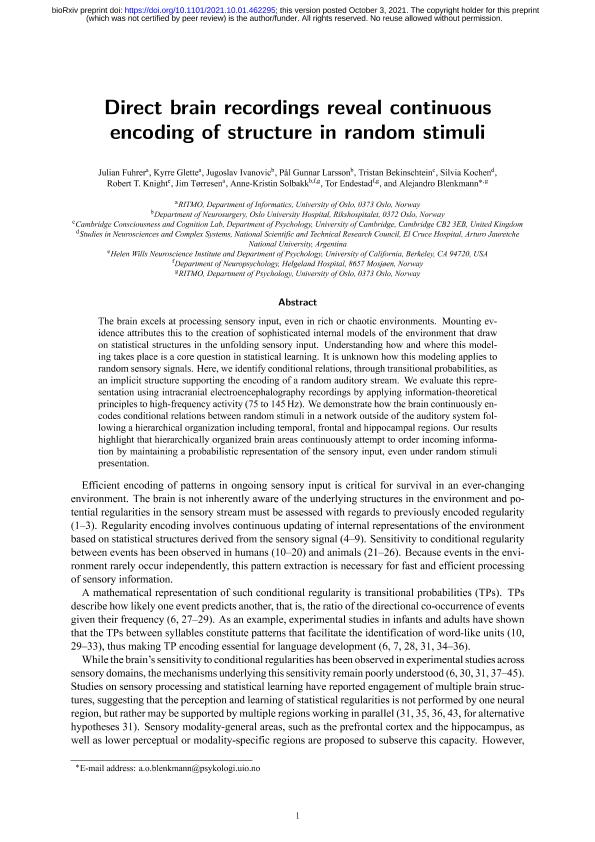Artículo
Direct brain recordings reveal continuous encoding of structure in random stimuli
Fuhrer, Julian; Kyrre, Glette; Ivanovic, Jugoslav; Gunnar Larsson, Pål; Bekinschtein, Tristán Andrés ; Kochen, Sara Silvia
; Kochen, Sara Silvia ; Knight, Robert T.; Tørresen, Jim; Solbakk, Anne Kristin; Endestad, Tor; Blenkmann, Alejandro Omar
; Knight, Robert T.; Tørresen, Jim; Solbakk, Anne Kristin; Endestad, Tor; Blenkmann, Alejandro Omar
 ; Kochen, Sara Silvia
; Kochen, Sara Silvia ; Knight, Robert T.; Tørresen, Jim; Solbakk, Anne Kristin; Endestad, Tor; Blenkmann, Alejandro Omar
; Knight, Robert T.; Tørresen, Jim; Solbakk, Anne Kristin; Endestad, Tor; Blenkmann, Alejandro Omar
Fecha de publicación:
10/2021
Editorial:
Cold Spring Harbor Laboratory Press
Revista:
bioRxiv
ISSN:
2692-8205
Idioma:
Inglés
Tipo de recurso:
Artículo publicado
Clasificación temática:
Resumen
The brain excels at processing sensory input, even in rich or chaotic environments. Mounting evidence attributes this to the creation of sophisticated internal models of the environment that draw on statistical structures in the unfolding sensory input. Understanding how and where this modeling takes place is a core question in statistical learning and predictive processing. In this context, we address the role of transitional probabilities as an implicit structure supporting the encoding of a random auditory stream. Leveraging information-theoretical principles and the high spatiotemporal resolution of intracranial electroencephalography, we analyzed the trial-by-trial high-frequency activity representation of transitional probabilities. This unique approach enabled us to demonstrate how the brain continuously encodes structure in random stimuli and revealed the involvement of a network outside of the auditory system, including hippocampal, frontal, and temporal regions. Linking the frame-works of statistical learning and predictive processing, our work illuminates an implicit process that can be crucial for the swift detection of patterns and unexpected events in the environment.
Palabras clave:
EPILEPSIA
,
CEREBRO
,
INTRACEREBRAL
Archivos asociados
Licencia
Identificadores
Colecciones
Articulos(ENYS)
Articulos de UNIDAD EJECUTORA DE ESTUDIOS EN NEUROCIENCIAS Y SISTEMAS COMPLEJOS
Articulos de UNIDAD EJECUTORA DE ESTUDIOS EN NEUROCIENCIAS Y SISTEMAS COMPLEJOS
Citación
Fuhrer, Julian; Kyrre, Glette; Ivanovic, Jugoslav; Gunnar Larsson, Pål; Bekinschtein, Tristán Andrés; et al.; Direct brain recordings reveal continuous encoding of structure in random stimuli; Cold Spring Harbor Laboratory Press; bioRxiv; 10-2021; 1-14
Compartir
Altmétricas



